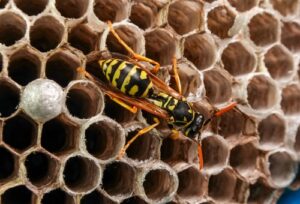Home / Blog / Ants / Carpenter Ants vs. Black Ants: Breaking Down the Differences
Carpenter Ants vs. Black Ants: Breaking Down the Differences

Scientifically reviewed by Rachel Maldonado
-Published on July 24, 2024
-Updated on October 29, 2025
Carpenter Ants vs. Black Ants: Breaking Down the Differences
Imagine waking up to find your wooden furniture riddled with holes or your kitchen counter swarming with ants. If you’re struggling with an infestation, knowing whether you’re dealing with carpenter ants vs. black ants is an important distinction to make.
Did you know that carpenter ants cause millions of dollars in damage each year? That’s because they burrow into wood to build their nests, weakening structures over time.
On the other hand, little black ants are more of a nuisance than a structural threat. Knowing the difference can save you time, money, and stress.
Both carpenter ants and little black ants might seem like just tiny pests, but these little critters can make a big impact on your home and shouldn’t be underestimated. Let’s break down their key differences.
What Are Carpenter Ants?
Carpenter ants are some of the largest types of ants you’ll ever come across. They range from 1/4 to 1/2 inch in length and are typically black or red and black. Unlike termites, carpenter ants don’t eat wood – they excavate it to create their nests.
Carpenter ants have a rounded thorax and a heart-shaped head. They lack the narrow, pinched waist that you might see in other ant species. Their large mandibles are perfect for gnawing through wood, a habit that can lead to significant structural damage over time.
These ants prefer moist, decayed wood but can also be found in dry, sound wood. They often enter homes through damaged wood, windows, or cracks in walls. Once inside, they form satellite colonies near moisture sources like sinks, bathtubs, and dishwashers.
To identify an infestation, you’ll want to look for piles of sawdust (since they do not consume the wood they are infesting), comprised of wood but also other ant and insect parts, near wooden structures – this is a telltale sign of carpenter ant activity. You might also notice rustling sounds in walls or hollow-sounding wood. If you see winged ants indoors, it’s likely that a colony has established itself inside your home.
What Are Little Black Ants?
Little black ants, also known as common house ants, are much smaller, usually about 1/8 inch long. They are jet black and have a more uniform body shape compared to carpenter ants.
Little black ants have a smooth, glossy appearance. Their bodies are divided into three distinct segments, and they have a pinched waist. Unlike carpenter ants, their mandibles are not strong enough to chew through wood.
These ants are often found in kitchens and bathrooms, attracted by food and water sources. They build their nests in soil, under rocks, and in wall voids. They’re less likely to cause structural damage but can still be a nuisance.
If you see a trail of little black ants marching towards food or water, you likely have an infestation of little black ants. They tend to form long lines as they move to and from their nests. You might also find small piles of dirt near entry points.
How to Identify and Control These Ant Species
Identifying the type of ant you’re dealing with is the first step in getting rid of the problem. To that goal, here are three key things to look for:
- Size and Color: Carpenter ants are significantly larger and can be black, red, yellow or a combination of both. Little black ants are smaller and uniformly black. Use a magnifying glass to get a closer look if needed.
- Nesting Habits: Carpenter ants nest in wood, while little black ants nest in soil or hidden spaces within your home. Finding the nest can help you determine which type of ant you’re dealing with.
- Behavior Patterns: Carpenter ants are more likely to be active at night. Little black ants are often seen during the day, foraging for food.
Once you’ve narrowed down the list of potential culprits, you’ll need to take steps to get rid of them.
For carpenter ants, if you believe they are nesting inside your home, your first step should be to find the nest by looking for sawdust piles and listening for rustling sounds. You can then apply insecticides directly into the nest. Ideally, you should consider enlisting professional help, like the team at Hawx, to make sure you’re applying the chemicals properly and safely.
For little black ants, baiting tends to be an effective strategy – these can be used near trails and entry points to your home, as the ants will then carry the poison back to their nests. You can use barrier treatments as well, like the insecticides described above.
Ultimately, for both of these pests, one of the best things you can do is to keep your home clean and free of food debris and moisture that can attract ants and other insects.
Carpenter Ants vs. Black Ants: Get Help Today!
If you’re tired of playing the ant guessing game, or have tried multiple methods of control and still see ants, it’s time to seek professional help. Carpenter ants can cause structural damage, so often, even the best DIY methods just aren’t enough.
Our team of experts at Hawx Pest Control has the expertise you need to nip any kind of ant infestation in the bud. We’ll help you keep your home safe, secure, and most importantly, ant-free.
Give us a call today to join our family of satisfied customers!
Related Articles
Visit our blog to learn more.
→








